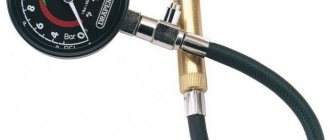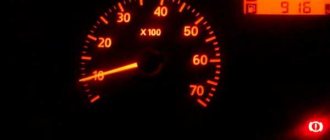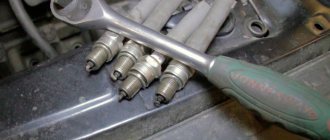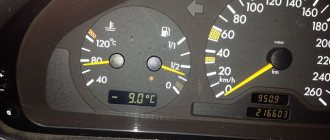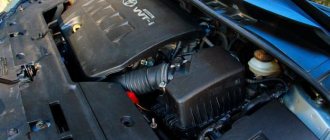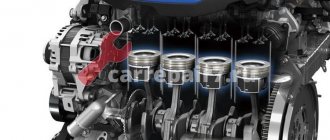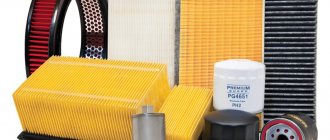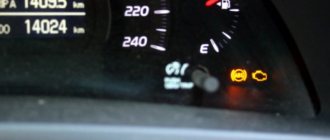Don't panic
When the engine starts and immediately stalls, many drivers begin to panic a little, because not every driver can immediately identify this malfunction. Pulling on wires, pipes, kicking the car wheel out of helplessness, as a rule, does not produce results.
Usually the car will start after a while, and then the situation may repeat itself.
I would like to note that the reason when the engine starts and immediately stalls can be various malfunctions specific to a particular car model, ranging from a malfunction of the VVT-i valve, or more precisely due to its clogging, and ending with burning of the fuel pump relay contacts which often happens on Honda cars.
It is worth noting that recommendations are given here not for complete dummies, but for those who can already independently perform simple work to identify the malfunction and eliminate it.
For people who do not understand anything about these issues, it is better to immediately go to a car service center, and if the engine starts and immediately stalls, and this is repeated several times without success, call a tow truck.
Diagnosis of IAC
How can you diagnose a faulty idle air control valve?:
- You stopped for 5 minutes after a long trip, naturally the engine is hot. After this, you try to start the engine, but the engine does not start or starts and immediately stalls. Even if the engine starts, the normal idle speed is not set immediately, but only after pressing the gas pedal more than once.
- The same situation can occur on a cold engine. The first time the engine starts and immediately stalls, but the second time it runs fine.
- Whatever the engine, hot or cold, it starts only when the gas pedal is depressed.
- The situation is the same as in point 3, but the accelerator pedal must be held constantly until the engine warms up or the car starts moving.
- You braked sharply and the car suddenly stalled; when you restart, the idle speed remains within normal limits.
- The idle speed hangs in an inflated range from 1500 to 2000 revolutions and only after revving it returns to normal values. Therefore, if your car’s engine starts and immediately stalls, try immediately flushing the throttle assembly and idle air control. If this doesn't help, just replace the IAC and that's it.
What does IAC look like?
What's the result?
As you can see, there are quite a few reasons why the engine starts running and stalls after starting. However, most of them are usually associated with the fuel system, ignition system and electronic control system.
In this case, it is appropriate to talk about low compression in the cylinders due to the fact that the engine has exhausted its service life (the cylinder walls, rings, etc. are worn out), that is, the unit needs major repairs. Compression can be measured at a service station or yourself using a compression meter.
The engine stalls at idle: what to check. Possible causes of malfunction on engines with a carburetor, injector, and diesel power plants.
At idle the speed “floats”: why does this happen? The main malfunctions associated with idle speed on gasoline and diesel engines.
The main reasons why the engine starts to stall after warming up. Frequent problems of carburetor and injection engines, fault diagnosis.
The reasons why, after pressing the gas pedal, dips occur and the engine begins to choke. Gas engine failures when switching from gasoline to gas.
Why the engine may not pick up speed: gasoline engine, diesel unit, car with LPG. Fault diagnosis, useful tips.
Reasons why the engine may stall when you press the brake. The power unit stalls during sudden braking, when the clutch and brake are depressed, etc.
Injector malfunction
The next reason that the engine starts and immediately stalls is a malfunction of the injector. Since most modern cars have a forced fuel injection system, this malfunction is very common.
Don't make mistakes.
What should not be allowed when operating fuel-injected cars:
- Do not disconnect the battery while the engine is running.
- Try to play with lighting as little as possible, and in general, handle food as carefully as possible. Injection cars are very sensitive to such manipulations.
- Try not to disconnect the ground on the car. Although I turn off the mains in my car in winter if I don’t drive for a long time, and so far I have not noticed any discomfort in operation, although many experts say that it is possible to erase information in the computer. I just try to let the car idle for up to 3 minutes when starting the engine.
- Injector-injected cars are not very fond of charging and starting devices, since when they are used, the voltage jumps significantly and the ECU can burn out.
ECU board.
- If a neutralizer is provided in the design of the car, then try not to start the car by towing or pushing it down a hill, as unburned fuel is formed, which, if it gets into the neutralizer, can ignite spontaneously.
- Do not allow water to enter the injector; this is strictly contraindicated. To do this, change fuel filters in a timely manner and fill with high-quality gasoline.
What does a neutralizer look like?
- If your car is equipped with an L probe and a neutralizer, then think about whether you should take the risk by using leaded gasoline. When using such gasoline, the L-probe, in addition to the fact that it itself can quickly break down, it will transmit incorrect data to the ECU, indicating a large amount of oxygen, and this, to put it mildly, is not very good, as it can lead to local overheating of the engine .
So, we return again to our problem, the engine starts and immediately stalls or does not start at all.
The engine starts and stalls: troubleshooting
So, if a similar problem appears, then it is necessary to take into account a number of features. First of all, the operation of the internal combustion engine after startup will be influenced by the following factors:
- fuel supply;
- air supply;
- spark on spark plugs (for gasoline internal combustion engines);
- correct operation of glow plugs (for diesel engines);
- proper operation of the ECM and electronic sensors;
With that said, you should first start by checking the main possible causes:
- Quite often, malfunctions in the operation of the alarm system and the anti-theft system can cause the engine to fail to operate after starting. In other words, the immobilizer does not turn off and continues to block the start of the internal combustion engine, which is its main function to prevent vehicle theft. If the alarm blocks the engine, then you need to check the operation of all elements, try to reset the error, turn off the anti-theft system, etc.
- Problems with the IAC and idle air valve often arise due to contamination of these elements. You should also pay attention to the cleanliness of the throttle valve. As for the crankshaft sensor, incorrect data that it transmits to the ECU can cause the engine to stall immediately after starting.
- Poor quality fuels and lubricants can also cause problems. As a rule, problems begin in cases where low-grade fuel was filled or the engine uses motor oil that does not meet the recommendations/has lost its properties.
- A faulty fuel pump, air leaks in the fuel line, the formation of air pockets and dirty fuel filters do not allow creating the required pressure in the power system or supplying fuel in the required volume.
- The air filter and its contamination leads to the fact that the working mixture is significantly over-rich. In other words, the engine does not have enough air to burn fuel, and the spark plugs flood.
- Problems with ECM sensors (EGR sensor, oxygen sensor, DPKV, etc.) can lead to both unstable engine operation at idle and a complete engine stop after starting.
Now let's look at the most common problems and how to fix them, looking at them in detail.
- First of all, the culprit may be the low level of fuel in the gas tank and its quality. If gasoline or diesel fuel runs out, then the engine will start using the remainder in the power system, but further operation will be impossible.
Complete sabotage
The most deplorable situation, the engine does not start at all.
First of all, you need to maintain composure and not scold the car itself. Only after this, we calmly begin to find out the reason why the engine does not start.
Do not allow the battery to be severely discharged by pointlessly rotating the engine crankshaft, the energy will still be useful to you, but where you will charge the battery if you are far from home is the question. Although for the electronic unit itself 8 Volts will be quite enough. But, of course, they won’t be enough for the starter.
When you have calmed down, be sure to check:
- How does the fuel pump work and is there any fuel in the tank?
- Is there ignition?
- Is the engine crankshaft timing sensor functioning?
- Have the injectors failed, although the failure of several injectors at once is too much, this happens very rarely.
- The ECU is working. But this device also fails very rarely.
The injector starts and stalls
Fuel-injected cars may behave this way due to a faulty fuel pump. It's in the tank. It is very easy to check its functionality. If you turn the ignition key to the first position and listen, you will hear the pump working, pumping gasoline into the system.
Severe contamination of the fine fuel filter can also cause the car to stall after starting. The filter simply does not have time to pass the required amount of gasoline.
Finding out the cause of the problem
Now let's figure out how to quickly find out:
- The performance of the fuel pump, of course, is determined by its sound. If there is no sound, then check the wiring and provide 12 V supply to it. Pay attention to the pressure in the fuel system, it should be within 2 - 3 bar while the pump is running. If the fuel supply is stopped, the pressure in the system does not drop immediately. If the pressure drops sharply and there are no fuel leaks, then pay attention to the fuel pressure regulator. At least it can be silenced for a short time.
- Checking the ignition. To avoid burning the ECU, the spark plug must be connected to ground as best as possible.
- When checking the synchronization sensor, first of all, we pay attention to the integrity of the wiring and its shielding.
- As for the ECU, you need to try to move all possible connections. There is a high probability that something has come loose somewhere.
- Notice if the Check Engine light is on. If it lights up, then all is not lost and the ECU is still working. You need to know that it is not yet possible on VAZ cars without a tester to find out the error code and identify the location of the fault.
- If a suspiciously large number of error codes are displayed, then you need to pay attention not to the sensors, but to the fact that some part of your car has completely disappeared.
- You should also pay attention to the performance of the crankshaft synchronization sensor and the performance of the injector control system. But all this requires a special tester, and rarely does anyone carry this device with them in their car. Yes, and it is advisable for specialists to perform such work.
- But many people can check the voltage in the network. As a rule, when the engine is running it should be 14 V, when starting the engine 8 V, and when the engine is not running 12.5 V.
- Be sure to check the integrity of the camshaft drive belt and pulley. It's not hard to do.
- And the last hope. We disconnect everything possible from the ECU (electronic control unit), only leaving the crankshaft synchronization sensor. But again, if you know what you're doing. If you don't know, it's better not to interfere.
The engine still starts, but it is problematic:
- Check the air filter for clogging. If you have completely forgotten where it is, then everything is clear. Go ahead, buy a new filter, or at least clean the old one.
- Check the fuel pump as described above.
- When starting the engine, depress the clutch, this will make starting easier.
- Pay attention to what temperature the coolant sensor shows and what it actually is. Deviations should be within 5, 6 degrees.
- Again, check the car's voltage. What voltage should be, see above, paragraph 8.
- Pay attention to the quality of the fuel. Ask yourself the question, “Where did I refuel today?”
- We move all possible connectors. It’s corny, but sometimes it helps.
- We look at the camshaft drive belt.
Also read why the car engine does not pull.
These are the simplest actions that are available to many drivers. To conduct a more detailed diagnosis of the cause of poor engine starting, of course, it is better to contact a car service center. Professional equipment and devices will already be used there.
If the car does not start, read about other reasons here.
What to do if the problem is in the ECU?
The engine may not operate properly if the on-board computer malfunctions. At VAZ, it is he who is responsible for the timely supply of fuel, synchronizing the operation of the injector nozzle and spark plugs. When the engine stalls immediately, this indicates a mismatch in the timing of fuel supply and ignition of the fuel mixture.
As a rule, changing the firmware or restoring it to the factory state helps. Although sometimes it may simply be necessary to adjust the fuel supply cycle, as well as the saturation of the mixture. In extreme cases, on a VAZ 2110 (or later model), you will have to replace the entire ECU unit or turn it off, switching the engine to manual operation only.
